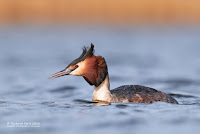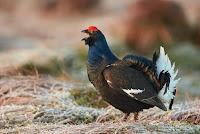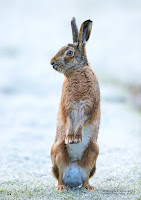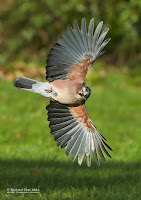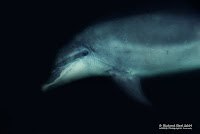Famous Grouse on the 'Rocks'
Winter does not seem the want to release its icy grip on the UK and let the warmth of spring push through just yet. As I write this post there is snow lying in the garden outside. The spring migrant birds that are starting to arrive must think they took a wrong turn somewhere en route.
Last week I decided to take a day heading northwards to see if I could find some golden plover on some grouse moors.
As I travelled northwards the amount of snow lying on the ground increased and I had not yet even headed uphill to the plateau where I was hoping to find the plover. The small track up to the hill top rapidly deteriorated for driving with increasing depths of snow until I came to drift which looked sort of passable but looked like it could quite easily trap the car. I sat for a while looking at it wondering if it was worth carrying on down the track, to where I hoped to find the plover, but settled on the side of caution in the end and decided to park up and head out on foot. The thought of the car being stuck on an isolated snow covered moorland did not hold much appeal. I am glad I took this approach as the first car that passed me skidded off the track into the moorland and the second, a transit van, got stuck for a long period.
I could hear the occasional piping call of the plovers, a beautifully bleak and pure sound penetrating across the expanse of the moorland, but the chance of getting close to them on foot seemed fairly remote especially as the snow either side of the track was often up to my knees. Not easy conditions to creep up on a bird, especially a very wary plover. Time for an alternative plan and photograph some Red Grouse. These were again not going to be an easy proposition given the conditions and the fact that they are not surprisingly wary of people in this area as they are usually pointing a gun at them. By the way for those of you wondering the title of this blog post refers to a well known Scottish Whisky, that uses the Red Grouse as its trademark, served on ice.
Anyway my efforts of crawling, creeping, sliding and falling through snow and heather did produce some photos in some very bitter conditions. I have not photographed grouse on snow before so it provided some new images to add to the library. I must admit I always really enjoy photographing grouse. Not only are they superb looking birds with their finely patterned plumage and red eye combs but they always raise a smile with their gurgling calls and always appear slightly comical in their behaviour to me.
My session was cut short at lunchtime by the weather closing in fast. When on these hill tops you can always see what weather is coming and the dark grey swooping across at ground level on the far side of the valley did not look good. Sure enough 30 minutes later and it arrived and with it both the light and I departed. A relatively brief but enjoyable session and I will now have to return to try for the plover once again in a couple of weeks when hopefully the weather has improved.
Saturday, March 23, 2013
Sunday, March 17, 2013
Caledonian Caper - Part 2
Following on from my previous post......we had decided to spend the afternoon heading upwards in search of that hardy white grouse of the mountain tops, the Ptarmigan. There was plenty of snow around and the warm daytime temperatures had melted the upper layers only for it to freeze in to a walking unfriendly ice sheet. Off into the wilderness we headed, trudging uphill with our heavy camera kit on our backs, and ice grips on our boots. Wearing numerous layers of clothing on a warm afternoon, after a short while I decided to take off my jacket and clip it in to my rucksack. Onwards and upwards. We had covered quite a distance when we came across a walker descending who said he had seen some birds about a further 30 minute walk up the trail.
15 minutes walking later and I decided to take a brief break to gather my energies before the final push for the ptarmigan that were now hopefully only a short distance ahead. It was when I took my rucksack off that I noticed my jacket had disappeared. However, what was of greater concern in the pocket were my car keys! Usually I put my keys in my trouser pocket, as you are not generally likely to lose them :). I looked back down the expansive landscape below in disbelieve thinking that the chance of finding a jacket with very effective camouflage to be slim.
So I started heading downwards looking for car keys and Andy headed onwards to try and find the birds. I walked for a long time with hope diminishing with increasingly weary steps and thoughts turning to locksmiths. Fortunately the coat had fallen on a large patch of snow rather than in the heather and a it was such a relief when I finally spotted it while trying to retrace the route of my earlier ascent. By this time it was getting late in the afternoon and it seemed pointless to re-head back uphill. So I called Andy and told him I was going to descend back to where the car was parked and a cafe sold the very comforting prospect of a hot chocolate. It seemed quite a long time before Andy arrived back in the car park with the light disappearing rapidly. He did find the birds but it had been a struggle to get any images particularly with light having dipped behind a nearby mountain.
Back at our accommodation, the first task was to download and backup the photos from the day. Over dinner we debated the plan for the next day. Return to the 'Caper' or go back in search of ptarmigan. A tough call as we had such a productive morning with the Caper and a good number of photos. In the end we decided to return to the Caper the following morning on the basis that is was such a rare opportunity and it was afterall the main purpose of the visit.
Another clear and frosty morning found us once more heading back into the woods to the Capercaillie location. It was another brilliant session with the bird. You will have to excuse me for posting so many images in this post but it will probably be a very long time before I do another one on Capercaillie. Once again the bird drifted back into roosting mode around lunchtime, signalling time for our departure.
Once again we debated whether we should try to look for something to photograph on the way back south but I was conscious that Andy also had another long drive straight after an already epic journey back to the Wirral.
As for as I was concerned it was mission accomplished for our Caledonian Caper. Such an enjoyable couple of days spent with a truly amazing bird. I sincerely hope that the efforts to conserve it from a second extinction in the UK are successful. This will not be my last trip with the camera to Scotland this year as I am scheduled to return in the mid-summer but will tell you more about that adventure nearer the time.
Following on from my previous post......we had decided to spend the afternoon heading upwards in search of that hardy white grouse of the mountain tops, the Ptarmigan. There was plenty of snow around and the warm daytime temperatures had melted the upper layers only for it to freeze in to a walking unfriendly ice sheet. Off into the wilderness we headed, trudging uphill with our heavy camera kit on our backs, and ice grips on our boots. Wearing numerous layers of clothing on a warm afternoon, after a short while I decided to take off my jacket and clip it in to my rucksack. Onwards and upwards. We had covered quite a distance when we came across a walker descending who said he had seen some birds about a further 30 minute walk up the trail.
15 minutes walking later and I decided to take a brief break to gather my energies before the final push for the ptarmigan that were now hopefully only a short distance ahead. It was when I took my rucksack off that I noticed my jacket had disappeared. However, what was of greater concern in the pocket were my car keys! Usually I put my keys in my trouser pocket, as you are not generally likely to lose them :). I looked back down the expansive landscape below in disbelieve thinking that the chance of finding a jacket with very effective camouflage to be slim.
So I started heading downwards looking for car keys and Andy headed onwards to try and find the birds. I walked for a long time with hope diminishing with increasingly weary steps and thoughts turning to locksmiths. Fortunately the coat had fallen on a large patch of snow rather than in the heather and a it was such a relief when I finally spotted it while trying to retrace the route of my earlier ascent. By this time it was getting late in the afternoon and it seemed pointless to re-head back uphill. So I called Andy and told him I was going to descend back to where the car was parked and a cafe sold the very comforting prospect of a hot chocolate. It seemed quite a long time before Andy arrived back in the car park with the light disappearing rapidly. He did find the birds but it had been a struggle to get any images particularly with light having dipped behind a nearby mountain.
Back at our accommodation, the first task was to download and backup the photos from the day. Over dinner we debated the plan for the next day. Return to the 'Caper' or go back in search of ptarmigan. A tough call as we had such a productive morning with the Caper and a good number of photos. In the end we decided to return to the Caper the following morning on the basis that is was such a rare opportunity and it was afterall the main purpose of the visit.
Another clear and frosty morning found us once more heading back into the woods to the Capercaillie location. It was another brilliant session with the bird. You will have to excuse me for posting so many images in this post but it will probably be a very long time before I do another one on Capercaillie. Once again the bird drifted back into roosting mode around lunchtime, signalling time for our departure.
Once again we debated whether we should try to look for something to photograph on the way back south but I was conscious that Andy also had another long drive straight after an already epic journey back to the Wirral.
As for as I was concerned it was mission accomplished for our Caledonian Caper. Such an enjoyable couple of days spent with a truly amazing bird. I sincerely hope that the efforts to conserve it from a second extinction in the UK are successful. This will not be my last trip with the camera to Scotland this year as I am scheduled to return in the mid-summer but will tell you more about that adventure nearer the time.
Monday, March 11, 2013
Caledonian Caper - Part 1
Firstly a big apology for the lack of recent posts. I have been having a 'blog holiday' to recharge the batteries. I figured I deserved a short break after 6.5 years.. Mind you I have been struggling with the photography over the last few weeks due to the continuously dire weather coinciding with my free time. I have been getting the odd photo here and there but nothing really constructive. Anyway, hopefully the weather should start to pick up soon , although certainly not for next week having just seen the forecast, and the first of the spring migrant birds are starting to come in to the south of the UK.
About 3 weeks ago I went on a bit of a road trip to the Highlands of Scotland. In fact it was a round trip of around 800 miles to go and photograph a single bird. Sounds slightly crazy but it was a very special bird and I will describe the trip over this and the next blog post. I was told of the location of this special bird and given that it is very Territorial, was confident it could be found. Mind you when your travelling so far for a single bird, doubts inevitably creep in to the mind 'would it still be there?' being the most important.
So late on the Sunday afternoon my very good friend Andy and I set off on the long journey northwards under the promise of a forecast of unusually fine Scottish weather for the next two days. It probably took about 6 hours to get to our destination and we arrived in darkness under crisp, clear star-filled skies. Having checked into our accommodation, it was time for an early night for an early start in the morning to go and find the special bird.
The next morning I pulled back the garden to see clear skies and a heavy overnight frost and after a hearty, if slightly unhealthy, full cooked breakfast we set out to find the bird. After a twenty minute drive we parked up along side a beautiful old pine forest with well spaced trees dripping in lichen and mosses. A short walk into the forest and we arrived at the 'spot'. Please do not email asking where this 'spot' is, as I will not be divulging to protect a species that is really struggling to survive in the UK! It took about 5 minutes to find the bird or more correctly for the bird to find us. The bird we had made this epic voyage for was a solitary rogue male Capercaillie.
For those of you not familiar with this bird I will you a bit of background. The Capercaillie (which is a corruption of the Gaelic meaning 'Horse of the Woods') is the world's largest grouse which is about the size of a small turkey. It was brought to extinction in Scotland in 1785 and was reintroduced in the 19th century. The population flourished to an estimated 10000 pairs in the 1960s but had plummeted to less than 1000 birds in 1999. It has been named rather depressingly as the bird most likely to become extinct in the UK by 2015. A range of factors have caused the decline including habitat loss, degradation and fragmentation, predation and the use of deer fencing which the birds unwittingly fly in to. A great deal of effort is being made to prevent the sad potential loss of this magnificent bird. Given its perilous status, and quite rightly, the bird is afforded legal protection under schedule 1 of the Wildlife and Countryside Act meaning that a licence is required to photograph the bird at breeding and lek sites. Fortunately our visit was outside the breeding season and the bird was solitary and so the need for a licence was removed.
A rogue bird is one that has not found a mate, and is completely overloaded with hormones and will quite happily attack anything within the vicinity regardless of size. They are a large powerful bird, with a very sharp beak and can cause damage. My friend Andy had a prolonged encounter with one in Scandinavia, as he was stuck in deep snow, which broke his finger. As with all wildlife photography the most important aspect is to show respect for your subject, unfortunately a testosterone filled 'Caper' shows a complete disrespect for photographers!
Light was fairly limited in the forest despite the clear skies as the low winter sun was shielded by the hillside behind. The first sight of this bird almost takes your breath away as it is very beautiful and just seems so fitting in these atmospheric forests as is stands their majestically surveying its domain. The call of the Capercaillie is slightly odd and sounds a bit like a series of pops, a bit like porridge going down a plug hole, although apparently a lot of the sound is beyond human hearing and carries long distances.
The morning of photography went very well with the bird strutting around and displaying, between bouts of feeding on heather and bark, before taking off vertically (which is impressive for a bird of that size) to roost at the top of a pine tree. It had been an amazing wildlife encounter and one that will stay with me until I am returned to the great global carbon sink. A special bird in a wonderful setting with amazing weather and very good company. It doesn't come much better than that.
Two happy photographers headed back to the car, leaving the snoozing 'Caper'. We decided we would try for another specialist in the afternoon, the ptarmigan. For me the afternoon did not go well as you will see in my next post.
Firstly a big apology for the lack of recent posts. I have been having a 'blog holiday' to recharge the batteries. I figured I deserved a short break after 6.5 years.. Mind you I have been struggling with the photography over the last few weeks due to the continuously dire weather coinciding with my free time. I have been getting the odd photo here and there but nothing really constructive. Anyway, hopefully the weather should start to pick up soon , although certainly not for next week having just seen the forecast, and the first of the spring migrant birds are starting to come in to the south of the UK.
About 3 weeks ago I went on a bit of a road trip to the Highlands of Scotland. In fact it was a round trip of around 800 miles to go and photograph a single bird. Sounds slightly crazy but it was a very special bird and I will describe the trip over this and the next blog post. I was told of the location of this special bird and given that it is very Territorial, was confident it could be found. Mind you when your travelling so far for a single bird, doubts inevitably creep in to the mind 'would it still be there?' being the most important.
So late on the Sunday afternoon my very good friend Andy and I set off on the long journey northwards under the promise of a forecast of unusually fine Scottish weather for the next two days. It probably took about 6 hours to get to our destination and we arrived in darkness under crisp, clear star-filled skies. Having checked into our accommodation, it was time for an early night for an early start in the morning to go and find the special bird.
The next morning I pulled back the garden to see clear skies and a heavy overnight frost and after a hearty, if slightly unhealthy, full cooked breakfast we set out to find the bird. After a twenty minute drive we parked up along side a beautiful old pine forest with well spaced trees dripping in lichen and mosses. A short walk into the forest and we arrived at the 'spot'. Please do not email asking where this 'spot' is, as I will not be divulging to protect a species that is really struggling to survive in the UK! It took about 5 minutes to find the bird or more correctly for the bird to find us. The bird we had made this epic voyage for was a solitary rogue male Capercaillie.
For those of you not familiar with this bird I will you a bit of background. The Capercaillie (which is a corruption of the Gaelic meaning 'Horse of the Woods') is the world's largest grouse which is about the size of a small turkey. It was brought to extinction in Scotland in 1785 and was reintroduced in the 19th century. The population flourished to an estimated 10000 pairs in the 1960s but had plummeted to less than 1000 birds in 1999. It has been named rather depressingly as the bird most likely to become extinct in the UK by 2015. A range of factors have caused the decline including habitat loss, degradation and fragmentation, predation and the use of deer fencing which the birds unwittingly fly in to. A great deal of effort is being made to prevent the sad potential loss of this magnificent bird. Given its perilous status, and quite rightly, the bird is afforded legal protection under schedule 1 of the Wildlife and Countryside Act meaning that a licence is required to photograph the bird at breeding and lek sites. Fortunately our visit was outside the breeding season and the bird was solitary and so the need for a licence was removed.
A rogue bird is one that has not found a mate, and is completely overloaded with hormones and will quite happily attack anything within the vicinity regardless of size. They are a large powerful bird, with a very sharp beak and can cause damage. My friend Andy had a prolonged encounter with one in Scandinavia, as he was stuck in deep snow, which broke his finger. As with all wildlife photography the most important aspect is to show respect for your subject, unfortunately a testosterone filled 'Caper' shows a complete disrespect for photographers!
Light was fairly limited in the forest despite the clear skies as the low winter sun was shielded by the hillside behind. The first sight of this bird almost takes your breath away as it is very beautiful and just seems so fitting in these atmospheric forests as is stands their majestically surveying its domain. The call of the Capercaillie is slightly odd and sounds a bit like a series of pops, a bit like porridge going down a plug hole, although apparently a lot of the sound is beyond human hearing and carries long distances.
The morning of photography went very well with the bird strutting around and displaying, between bouts of feeding on heather and bark, before taking off vertically (which is impressive for a bird of that size) to roost at the top of a pine tree. It had been an amazing wildlife encounter and one that will stay with me until I am returned to the great global carbon sink. A special bird in a wonderful setting with amazing weather and very good company. It doesn't come much better than that.
Two happy photographers headed back to the car, leaving the snoozing 'Caper'. We decided we would try for another specialist in the afternoon, the ptarmigan. For me the afternoon did not go well as you will see in my next post.
Subscribe to:
Posts (Atom)
















.jpg)
.jpg)
.jpg)
.jpg)
.jpg)
.jpg)
.jpg)


.jpg)
.jpg)
.jpg)
.jpg)
.jpg)




